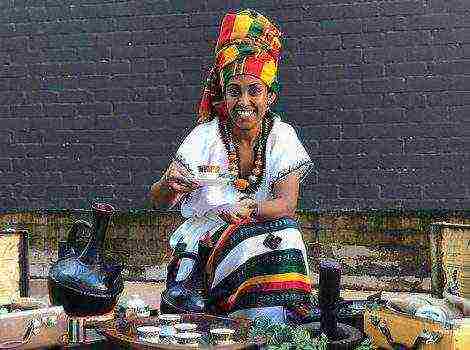Content
- 1 Useful properties of zucchini
- 2 Optimal conditions for growing zucchini and the technology of planting seeds for seedlings (with video)
- 3 How to properly grow zucchini in the open field in the country and how to store the crop
- 4 What varieties of zucchini and zucchini are the best for open field in the Moscow region
- 5 The most productive varieties of zucchini and zucchini: photos, names and descriptions
- 6 Varietal variety of zucchini
- 7 The best bush varieties for outdoor cultivation
- 8 Best self-pollinated parthenocarpic species
- 9 Early varieties
- 10 Medium ripening
- 11 Late zucchini
Zucchini - a kind of ordinary zucchini, brought to us from Italy a couple of decades ago. According to some of their characteristics, these vegetables differ for the better from all the familiar white-fruited zucchini crops - they are more compact and the yield indicators are higher, which is why they are very popular in Europe and America.
Extremely juicy and delicate in taste, zucchini contain easily digestible carbohydrates, carotene, PP vitamins and ascorbic acid in the pulp. And as storage proceeds, sugars are also deposited in the fruits.
You can cook all the same dishes from zucchini as from zucchini. Young zucchini can be used raw, rubbed into salads. For the winter, they can be pickled (separately or with other vegetables), salt, and ferment.
Many hybrids and varieties of zucchini have already been bred. Each of them is distinguished by the color of the peel, the shape of the fruit and the ripening period. And if medium-sized oblong zucchini can be found in the gardens of many summer residents, then small, bright yellow or round zucchini are still rare in our country. And it’s in vain - the plant, with proper care, is quite capable of growing and giving abundant harvests in the difficult Russian climate.
Agricultural technology of cultivation zucchini is the same as white-fruited zucchini.
It differs only in the following: do not allow high humidity. Therefore, if you grow zucchini under plastic, open it daily for airing. Also, when watering, try not to get a stream of water on the leaves and ovaries.
Consider the most popular zucchini hybrids and varieties.
| Tsukesha. A weakly branching bush of this variety gives consistently high fruiting. The fruits are ready to be harvested no later than 50 days after planting. Each weighs 0.9 kg. The pulp is very tasty, suitable for pickling and salting. Tsukesha can be stored without any processing, without losing its taste, for a couple of months. |
|
| Black handsome. This variety is especially appreciated by summer residents for its long fruiting period and high yields. It is suitable for planting vegetables directly in the open ground. The bush forms fruits of a dark green (almost black) color, with a glossy surface, weighing up to 1.0 kg. The pulp is light, quite dense, tender to the taste. And the palatability does not deteriorate either during canning or during cooking. |
|
| Aeronaut. The variety is suitable both for open ground and for cultivation in greenhouse conditions. Cylindrical, dark green speckled fruits ripen early. Each weighs 1.3 kg. The pulp is whitish-yellow, thick, juicy and tasty. The aeronaut is, perhaps, the most popular variety among our gardeners, due to its good transportability and considerable, if compared with some other varieties, shelf life. |
|
| Yellow-fruited... This high-yielding zucchini is more suitable for planting seeds directly into the garden without using seedlings.Fruits are cylindrical in shape with a slight narrowing towards the peduncle, weighing up to 0.9 kg, rich yellow color. Due to the content of carotene in zucchini, Zheltoplodny is excellent for dietary and baby food. | |
| zebra. This one of the highest yielding varieties ripens early - it takes 38 days for the zucchini to reach full ripeness. Fruits are pale green in color with dark green stripes (from bottom to top) over the entire surface, weighing 0.5 kg, with a slightly yellowish flesh. Zucchini Zebra is well transported and does not lose its presentation for a long time. Due to its resistance to cold weather, it grows and bears fruit actively even in cold climates. It is noticed that during the period of a strong drop in temperatures, the variety can stop its growth, and with the onset of heat, it can begin to develop again. |
|
| Golden scallop. This is a medium-ripening variety. Zucchini - cylindrical, slightly lumpy, yellow in color, growing up to 2.0 kg. The pulp is light in color, juicy and tender on the palate. The golden scallop is eaten fresh and used for canning, it is perfectly stored under certain conditions and is transported, it is characterized by a low calorie content. |
|
| Kuand. Shrub or semi-shrub culture with medium ripening periods, giving consistently high fruiting. Fruits are cylindrical, light green in color with irregular stripes, weighing 1.5 kg. Despite the rather large size of the zucchini, the flesh is tender and juicy in taste. The variety is practically not exposed to powdery mildew and gray rot. |
|
| Negro. It is a high-yielding early-maturing variety suitable for open-bed seeding. Fruits - 0.7-0.9 kg, cylindrical, original black and green shade. The pulp is juicy and tasty, greenish in color. The black baby is well resistant to powdery mildew. |
|
| Nephritis. This is a mid-season zucchini hybrid, bred a little over 10 years ago. Leaves of a small-leaved bush - strongly dissected, with a mottled surface. Fruits are green in color with lighter stains over the entire surface, smooth to the touch, weighing up to 1.2 kg. The pulp is pale creamy, fibrous, very tasty. Zucchini Jade is recommended to be grown in the North-West regions of our country. |
|
| Ronda (Ronde De Nice). It is a medium-ripening variety with a long fruiting period. A high yield of vegetables can be harvested in 1 season. Fruits are round (somewhat similar to pumpkin), grayish-green with dark stripes and white spots. Ronda is removed from the beds when they reach a diameter of 8-10 cm. |
|
| Tintoretto. It is an early ripening variety characterized by a non-branching bush and rounded oval courgettes. Leaves are finger-like, large, pubescent, monochromatic. The yellow speckled fruit grows quite massive - up to 2.2 kg. This variety is famous for its high yield rates. |
|
| Banana. This early ripening variety bears numerous golden-orange fruits up to 25 cm in length. The pulp is slightly yellow, rather thick and dense, juicy and tasty. Banana is well stored and transported. |
|
| Zolotinka. On a semi-pebble early ripening plant, golden-yellow fruits weighing up to 1.3 kg are formed. The pulp is thick, yellow in color, slightly sweet in taste. Zucchini, with proper care, give a high yield and can be stored for a long time. |
|
| Tiger cub. This variety is distinguished by its original skin color - green with lighter stripes and specks. Fruits are cylindrical in shape, weighing up to 1.1 kg. The pulp is tender and tasty, light cream in color, quite dense, with a high content of nutrients. |
Among the new varieties of zucchini, the following names can be mentioned: Vanyusha, Burzhuin, Mini zucchini.
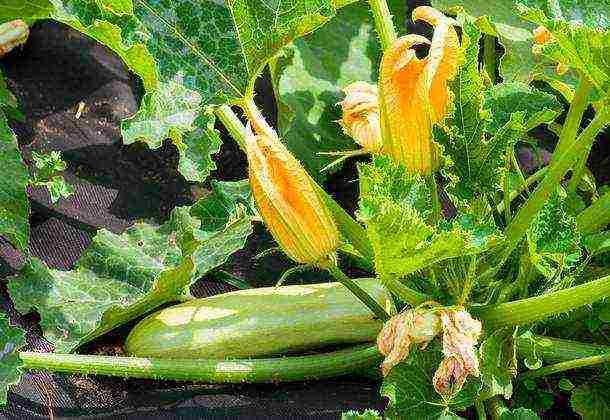
Zucchini - an unassuming crop for growing outdoors, even in conditions with not the hottest climates. It is easy to cultivate and its variety is zucchini.As long-term practice shows, it is best to grow zucchini through seedlings, but even with direct planting of seeds into the soil, you can get a good harvest. The main thing is to choose a suitable variety and perform simple agricultural techniques.
Quite a popular crop among gardeners is zucchini, which is a type of hard-bore pumpkin. Its homeland is South and Central America. It is believed that it came to the territory of Russia at the beginning of the 19th century from Turkey or Greece.
In this article, you will learn how to grow zucchini and zucchini in the open field, as well as which varieties of these crops will give the highest yield in the Moscow region.
Useful properties of zucchini
Zucchini - annual plants of the pumpkin family. Usually bush, but there are semi-bush and long-lined forms. Plants have a taproot, strongly branched root. The whole plant is covered with hard hairs. Flowers are dioecious, monoecious, yellow. The fruits are oval, cylindrical, elongated, covered at a young age with a very delicate skin.
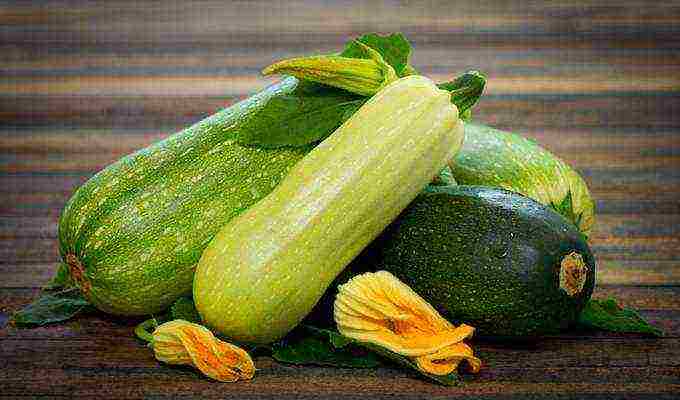
Nowadays, the zucchini variety is widespread - they are very similar in description, only the zucchini bush weakly branches, the pubescence of all organs is soft. The color of the fruit is varied: from green to golden with many shades. A very early ripening culture, with unusually long-term fruits, which can be eaten raw at a young age.
Zucchini is considered a medicinal vegetable with high beneficial properties. Zucchini pulp contains 4-12% dry matter, 2% sugars, pectin substances, 12-40 mg% vitamin C. It is rich in carbohydrates, proteins, magnesium, phosphorus, potassium, calcium, potassium, vitamins of groups A, E, B and many other substances necessary for the body.
Zucchini - a dietary product that cleanses the body of harmful salts. They improve digestion, help with kidney and gall bladder diseases, and improve blood composition. Useful for arthritis, gout. They are used to treat gastritis and stomach ulcers. In cosmetology, zucchini is used to rejuvenate and lighten the skin.
In medical practice, zucchini are used as an active diuretic, they promote the elimination of water and table salt.
To properly grow squash and zucchini, follow the tips below.
Optimal conditions for growing zucchini and the technology of planting seeds for seedlings (with video)
At the first stages of cultivation in the ground, marrows are demanding on heat, the optimum temperature for seed germination is 25-27 ° C, the minimum temperature for germination is 12-15 ° C. Plants do not tolerate frosts, only some varieties can withstand a short-term drop in temperature to 6-10 ° C. They are resistant to drought, but watering is necessary to obtain high yields. Proper growing technology requires that zucchini and zucchini be provided with sufficient sunlight as they do not tolerate shade well.
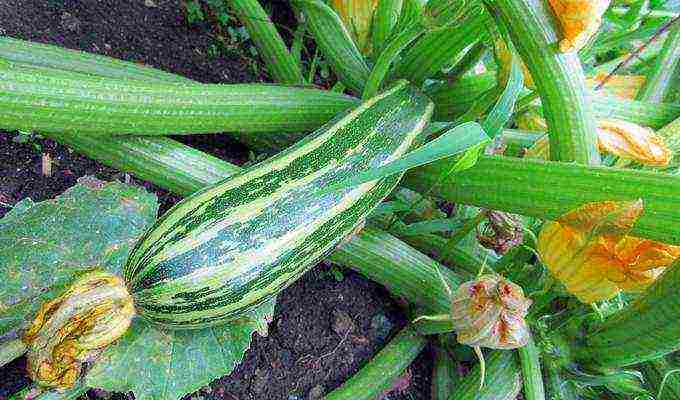
Both crops are demanding on soil fertility, do not tolerate increased soil acidity, soils with a reaction close to neutral are preferable. Proper crop rotation is an important prerequisite for growing squash and zucchini. The optimal predecessors are early harvested green crops, tomatoes, root crops.
Presowing seed preparation for growing zucchini is the same as for pumpkin. They can be sown in nutrient mixtures for seedlings or directly into open ground.
Planting of zucchini and zucchini for cultivation in the southern regions is carried out in a seedless way, in the Non-Chernozem zone - both seedling and seedling.
The nutrient mixture is needed for crops the same as for pumpkin. Sowing is carried out in such a way that 25-35-day seedlings are planted in open ground (approximately seeds are sown in the first ten days of May). Planting depth - 3-5 cm; the optimum temperature for germination is 18-23 ° C, the seedlings are kept for the first 4-5 days at a temperature of 15-20 ° C during the day and 12-15 ° C at night, and then the temperature is increased to 17-21 ° C.
Seedlings are planted when growing zucchini and zucchini in the phase of 2-4 true leaves, 1 plant per hole, rejecting all sick, frail plants. The feeding area for one plant is approximately 50 cm2.
Light, fertile, low groundwater soils are most suitable for squash. Remember that zucchini does not tolerate acidic soils (if necessary, lime them).
The plot is prepared in the fall, applying organic and mineral fertilizers (up to 4-6 kg / m2 of manure, humus or compost, 30-35 g / m2 of superphosphate, 15-25 g / m2 of chloride or potassium sulfate. If the reaction of the soil is acidic, then it lime under the culture preceding the zucchini). In the spring, 15-20 g / m2 of ammonium nitrate is introduced.

Seeds are sown in open ground when the threat of frost has passed, or earlier, but with the obligatory cover, which is then removed.
Seeds are buried to a depth of 4-9 cm, depending on the structure of the soil (deeper on the lungs). A feeding area of one square meter is designed for 3 plants. In each hole, 2-4 seeds are sown, followed by pinching off the excess (leave only one plant).
After sowing, to prevent drying out of the soil, the holes are mulched.
How to properly grow zucchini in the open field in the country and how to store the crop
When caring for courgettes and growing zucchini, top dressing, especially at the beginning and during fruiting, helps to increase yields. Top dressing is carried out with an infusion of mullein (mullein bucket for 5 buckets of water) or bird droppings (1 liter of droppings for 2 buckets of water) with the addition of 30-40 g of potassium sulfate and superphosphate. In order to grow zucchini or zucchini in the country strong and healthy, during the growing season, the soil between the plants is kept in a loose and weed-free state.
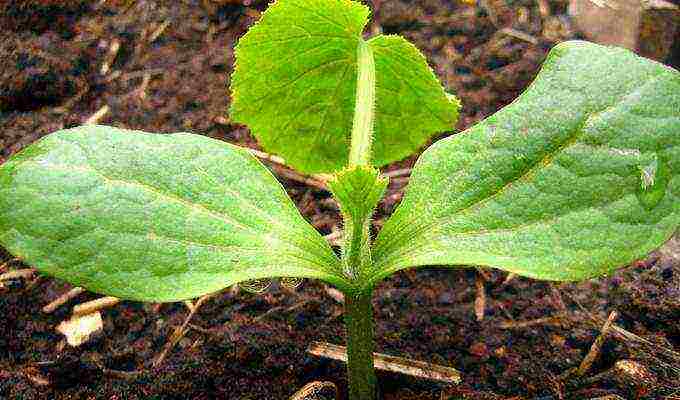
Zucchini can be grown under temporary cover films. The main thing is to monitor the humidity of the air, since the zucchini does not tolerate high humidity and stagnant air. To do this, ventilate. When the threat of frost has passed, the film is rolled up, and in the fall, during cold snaps, the plants are again covered. In this way, you will get both an earlier and a later harvest.
Important: the emergence of seedlings will accelerate the covering of crops with a film stretched over arcs. Shelters are aired daily, since zucchini do not like high air humidity very much. In cold, wet weather, artificial pollination should be carried out.
Since in zucchini and zucchini fruiting can continue until frost, watering must be carried out regularly - once every 7-8 days, spending up to 5-6 liters per plant. In this case, water should not get on the leaves and ovaries. It is recommended to stop watering a week before harvesting in order to improve the quality of the fruit. When caring for zucchini and zucchini during cultivation in the country, you should regularly remove the leaves of the lower aging tier.
Zucchini are affected by powdery mildew, white rot. Control measures are the same as for cucumbers. Dusting plants with colloidal sulfur with preliminary watering to adhere the drug to the leaves helps well against powdery mildew.
Sometimes they ask the question: why are zucchini bitter? Zucchini are bitter only when they are “uncomfortable”, that is, when they lack one or several factors at once for normal growth and development, for example, nutrition, moisture, heat, etc. Some varieties react less to deficiencies in conditions (“ Gribovsky-37 "), others are stronger, that is, the bitterness in the fruit also depends on the variety.
Watch the video "Growing zucchini and zucchini", the year shows all the main agricultural practices:
In July-August, as a rule, zucchini actively bear fruit. The crop is harvested 2-3 times a week, without allowing the fruits to overripe. Otherwise, they lose their taste, and the ripening of other ovaries on the bush slows down.
The harvest begins to be harvested upon reaching the consumer ripeness of the fruits, that is, when they are 15-20 cm long and 5-7 cm in diameter. Zucchini usually reach this size in a week and a half after the ovary appears. Such zucchini are the most delicious.The fruits are cut with a sharp knife (without damaging the plant) with a stalk once every 2-3 days.
Zucchini can be stored for up to three weeks in plastic bags in the refrigerator at a temperature of 1-2 ° C. Well-ripened fruits in room conditions can be stored for up to three months or more.
Next, you will find out which varieties of zucchini and zucchini are considered the best for growing in the Moscow region.
What varieties of zucchini and zucchini are the best for open field in the Moscow region
Adaya F1... An early ripe hybrid of the first generation of zucchini for growing in open and protected ground. The growing season is 47-51 days. Bush plant. The fruit is cylindrical, weighing 0.7-1.4 kg. Suitable for canning.
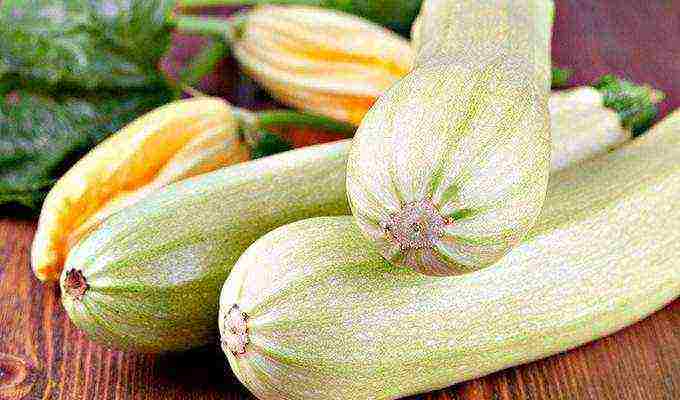
Anna... The variety is early maturing. Bush plant. The fruit is cylindrical, weighing 1-2 kg, smooth, light green, without mesh and pattern. This is one of the best zucchini varieties with a thin, woody bark. The pulp is white, dense, tender, slightly juicy, unsweetened. Used in home cooking. The propensity to get sick is above average.
Aeronaut. An early maturing variety of the zucchini type for growing outdoors and especially under temporary shelters. The growing season is 46 days. Bush plant. The fruit is cylindrical, weighing 1-1.5 kg, smooth, dark green. The bark is thin and fragile. The pulp is whitish-yellow, crispy, dense, tender, juicy, slightly sweet, very tasty. Susceptible to powdery mildew and viral diseases. Used in home cooking.
Belogor F1... An early ripe hybrid of the first generation. The plant is bushy, compact. The fruit is cylindrical, weighing 0.5-1 kg, smooth, greenish-white, without a grid and pattern. The pulp is white, dense, tender, slightly juicy, unsweetened. Transfers temperature fluctuations. The tendency to disease is above average, gray rot is average. Suitable for canning and cooking squash caviar.
White-fruited... An early ripe variety of zucchini for growing in the Moscow region in open and protected ground. The growing season is 36-44 days. Demanding on soil fertility and moisture. Bush plant. The fruit is cylindrical, weighing 0.6-0.7 kg. smooth, slightly ribbed at the base, whitish. The bark is of medium thickness, woody. The pulp is white or light yellow, medium density, good taste. Fruits are resistant to bacteriosis, but can be affected by gray rot. Used in home cooking and canning.
Genovese (Genoese)... An early ripe variety of the zucchini type. The plant is bushy, has a spreading rosette of leaves.
As you can see in the photo, this zucchini variety has cylindrical fruits, smooth, gray-green, 17-19 cm long:
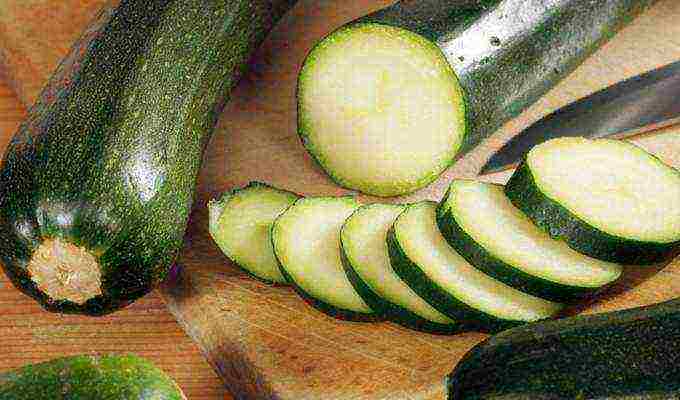
Long-fruited. Early ripe variety. The period from mass shoots to the first harvest of fruits is 45-50 days, the growing season is 105-115 days. The plant is bushy, compact, short-climbing. The fruit is cylindrical, corrugated at the base, smooth, pale green. When describing this variety of zucchini, it is worth noting that the bark of the fruits is thin, fragile. The pulp is white with a greenish tint, 1-2 cm thick, dense, tender, slightly sweet, juicy. Seeds are pale cream, smooth, of medium size.
Yellow fruited... An early ripe variety of the zucchini type. The period from full germination to technical ripeness of fruits is 43-62 days. Bush plant. The fruit is cylindrical, weighing 0.7-1.8 kg, yellow with an orange mesh. The pulp is creamy and light yellow, of good taste.
Zebra. An early maturing variety of the zucchini type for growing outdoors and especially under temporary shelters. Bush plant. The fruit is cylindrical, weighing 0.5 kg, slightly ribbed, light green with wide longitudinal dark green stripes. The bark is of medium thickness, fragile. The flesh is whitish-yellow, crispy. dense, tender, juicy, slightly sweet, tasty. Susceptible to powdery mildew, viral diseases and fruit rot. Used in home cooking.
Spool. Early ripe variety. This variety of zucchini, suitable for the Moscow region, has a ripe fruit of a golden yellow color, oval in shape, the skin is dense, the flesh is thick.
Gold Cup. An early ripening, cold-resistant variety of the zucchini type. Tolerates sudden changes in temperature. The plant is powerful, bushy, the fruits are cylindrical, bright yellow, 16-18 cm long. The fruits retain their qualities for a long time and become even tastier when lying down.
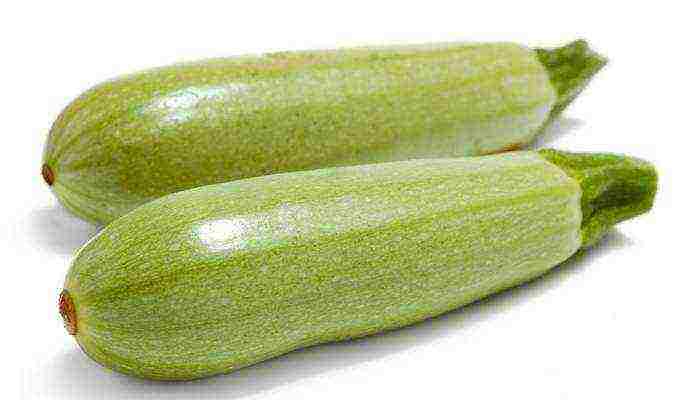
Kveta MC... An early ripe variety for cultivation in gardening, household plots and farms. The period from full germination to technical ripeness of fruits is 34-54 days. Semi-bush plant. The main lash is up to 1 m long. The fruit is cylindrical, weighing 0.7-1.8 kg. good taste. This is one of the best varieties of zucchini for the Moscow region, suitable for canning and cooking caviar.
Milanese dark green. An early ripe variety of dwarf zucchini. The plant has a spreading rosette of leaves. Fruits are cylindrical, slightly ribbed, 15-16 cm long.
Milanese black (Black handsome)... A mid-early variety of the zucchini type. Bush plant. Fruits are cylindrical, dark green, 20-25 cm long.
Multi-storey. Mid-season variety of the zucchini type. The bush is compact, with few leaves. Fruits are cylindrical, green with small light blotches, with tender juicy pulp. They retain their qualities well until March.
Negron F1. An early ripe hybrid of the first generation for growing in the open field and under the film. Fruits are dark green, up to 50 cm long.
Nephritis. Mid-season variety of the zucchini type of the day of cultivation in gardening, household plots and in farms. The period from full germination to technical ripeness of fruits is 53-58 days. The plant is bushy, sparsely plaited. The fruit is cylindrical, weighing 0.7-12 kg, high culinary qualities.
Odessa 32. One of the best early-ripening marrow varieties, suitable for growing in the open field of the Moscow region. The growing season is 43-50 days. Cold-resistant, low keeping quality, average transportability. Resistant to fungal diseases. Bush plant. branching. The fruit is cylindrical, wide, weighing 0.6-1.2 kg. light green. Light green or pink pulp, good taste.
Striped from Italy. Mid-season variety of the zucchini type. The plant has a bushy shape. Fruits are elongated-cylindrical, 20-22 cm long.
Video clip. One of the best ultra-early ripening marrow varieties for open ground. The growing season is 36-38 days. The variety is resistant to low temperatures. It is weakly affected by gray rot of fruits, moderately affected by powdery mildew. The plant is bushy, the main stem is 35 cm high. The fruit is oval, smooth, weighing 0.9-1.3 kg. without grid and pattern. The pulp is light green, loose, tender, slightly juicy, unsweetened. Used in home cooking and canning.

Sosnovsky. An early ripe zucchini-type zucchini variety. Ripeness occurs on the 34-57th day from the emergence of shoots. Fruits are white or cream-colored, rather large, with slight ribbing, weighing 0.9-1.6 kg. The pulp is yellow, fibrous, tender and juicy.
Sote 38... Early ripe variety. The growing season is 40-50 days. Demanding on the soil. Powdery mildew affects mild to moderate extent. Bush plant. In this one of the best varieties of marrow for open ground, the fruit has a narrow (4-6 cm) and long (24-30 cm) cylindrical shape, greenish green, weighing 0.6-1.1 kg. The pulp is dense, white, of good taste. The variety is designed specifically for the production of canned zucchini, cut into circles.
Tivoli F1... A hybrid of the first generation of squash-spaghetti. Bush type plant. The fruits ripen 100-120 days after sowing. Fruits are oval, weighing up to 1.5 kg. with cream-colored pulp. Spaghetti is prepared from ripe fruits by cutting them in half and raking out the fibers contained there with a spoon, which are boiled for 20 minutes in boiling water.
Helena. An early ripe variety of the zucchini type. The period from full sprouting to technical ripeness of fruits is 41-57 days. Bush plant. Fruit weighing 0.5-0.9 kg, at technical ripeness golden yellow, ripe orange. The pulp is yellow.Recommended for canning and home cooking.
Anchor. Early ripe variety. The growing season is 36-48 days. Differs in relatively high cold resistance and drought resistance. Medium resistant to powdery mildew and gray mold. Bush plant, weak foliage, predominantly female flowering type. The fruit is cylindrical, smooth, with a weak escape to the stalk, weighing 0.6-0.7 kg. light green at technical maturity, light yellow at maturity. The bark is thin. fragile. The pulp is light yellow, firm. Used in home cooking.
In this selection of photos - varieties of zucchini and zucchini, the description of which is presented above:

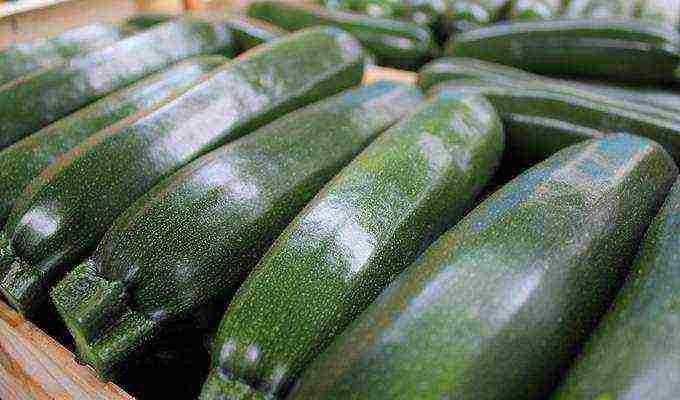
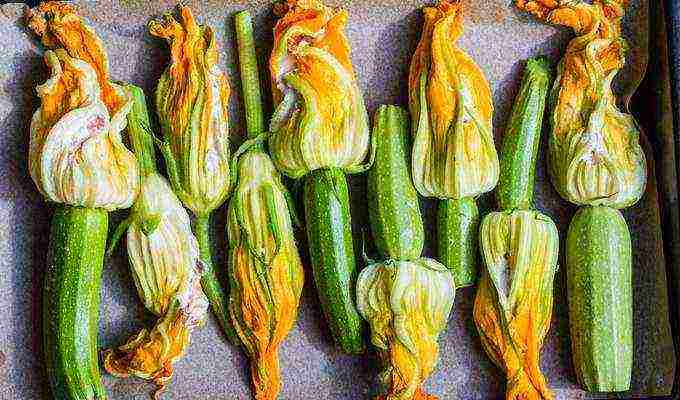
The most productive varieties of zucchini and zucchini: photos, names and descriptions
Goldrush F1. A very early, high yielding first generation hybrid. Ripens 50 days after planting the seedlings. Fruits are golden yellow, 20-25 cm long.
Gribovsky 37. Early ripe variety. From germination to the first harvest of fruits 50-60 days, fruiting period 35-40 days, vegetation period 100-110 days. Recommended for growing outdoors and greenhouses. This variety of zucchini is very fruitful, disease resistant. The plant is bushy, less often semi-bushy. The fruit is cylindrical, smooth, with a slight ribbing at the stalk, medium-sized, pale green in the ripeness of the table, in biological cream. The bark is hard. The seminal cavity is large. Mainly for table purposes, 8-12-day-old ovaries, fresh and canned, are used for food.
Kuand. An early ripe high-yielding variety of the zucchini type. The best results under our conditions are obtained when grown in greenhouses. Cold resistant, tolerates temperature fluctuations. The variety is relatively little susceptible to gray mold and powdery mildew. The plant is bushy or semi-bushy (there are also non-bushy forms). The fruit is cylindrical with an escape to the peduncle, weighing 1.1-1.6 kg, 20-30 cm long. Pale green with intermittent dark green stripes. The bark is thin. The pulp is white, dense, tender, tasty. Used in home cooking.
Nemchinovsky F1. An early ripe hybrid of the first generation. The growing season is 43-50 days. Differs in high productivity. Bush plant. The fruit is cylindrical, slightly clavate, with a smooth or slightly ribbed surface, weighing 0.6-1 kg, light green. The bark is thin, leathery. The pulp is white, tender, juicy, good taste. Used in home cooking and canning.
Pharaoh. Early ripening, very productive, cold-resistant variety such as zucchini. The first fruits ripen on the 39-43rd day after germination. Plant with a compact, sparse bush and cylindrical fruits with a slight escape to the peduncle. The fruits of the zucchini variety called "Pharaoh" are dark green, in biological ripeness, black-green. Fruit weight 0.8-1.2 kg. length up to 60 cm. The pulp is yellow, juicy and tender, very sweet, 3 cm thick. The fruits perfectly retain their qualities during the winter.
Tsukesha. One of the best early maturing zucchini varieties with a growing season of about 50 days. The best results under our conditions are obtained when grown in greenhouses. Demanding on the soil. It is moderately affected by gray rot. Bush plant. The fruit is cylindrical with an escape to the peduncle, up to 40 cm long, 12 cm in diameter, weighing about 0.9 kg. smooth, dark green, speckled. The bark is thin. The pulp is white, juicy, of medium thickness. Differs in high productivity and good taste.
Embassy F1. Early ripe, One of the most productive varieties of zucchini, a hybrid of the first generation of the zucchini type. Gives 20 greens from a bush. Fruits are green, up to 80 cm long. Good for storage.
These photos show zucchini and zucchini of the best varieties:

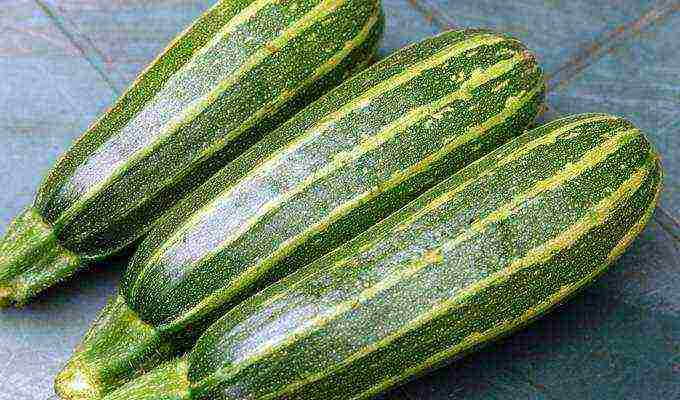
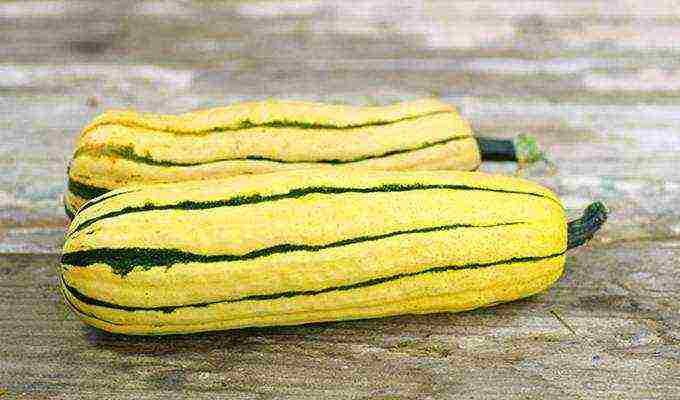
It's hard to imagine a vegetable garden without a vegetable marrow. This vegetable is one of the first to be harvested and appears on tables in the form of various dishes.The ease of growing zucchini, availability, early maturity and other characteristics allow, with proper care, to grow these plants of various varieties in open ground, greenhouses and greenhouses in Siberia, Moscow region and in the Leningrad region.
Varietal variety of zucchini
Our grandmothers did not think much about the varietal characteristics of the plants grown and from year to year they collected their seeds from the best fruits. Sometimes a new variety appeared on the site, but its main characteristic was color spectrum fruits: white, green, yellow, etc. with
The arsenal of modern gardeners is much wider and the color scale as a sign has faded into the background. Attention is paid to such characteristics as:
- Ripening terms (early, middle, late);
- Growth type (bush, climbing);
- Pollination features (parthenocarpic or insect pollinated);
- Productivity.
These and other characteristics allow the rule to select a species for specific conditions and get the most out of each plant.
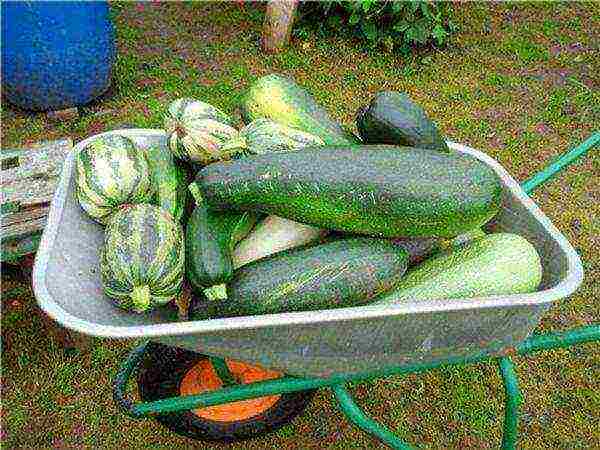 To get a good harvest, you need to select a variety according to its characteristics.
To get a good harvest, you need to select a variety according to its characteristics.
Among the variety of zucchini, special attention should be paid to varieties that have earned the recognition of breeders and are most popular with gardeners. Each group has its own favorites. Someone is convenient due to their ripening time, and someone conquers with their compactness.
The best bush varieties for outdoor cultivation
Most asthenia of the Pumpkin family form long, spreading whipsthat require large areas. At the same time, modern summer residents and gardeners are often limited to 6 acres, on which they want to plant a variety of crops.
The limited space and savings of every meter make planting traditional climbing varieties a real luxury, but bushy ones become a godsend for such sites.
Bush squash you can easy to fit into tight spaces and even plant in a flowerbed among flowers, where large leaves will be an excellent backdrop for other plants.
Aeronaut
Compact plant. Shows good disease resistance.
Fruits are green, 14-15 cm long, tasty, versatile. They perfectly withstand transportation. Subject to the rules of agricultural technology from 1 sq. m of area can be collected 7-7.5 kg.
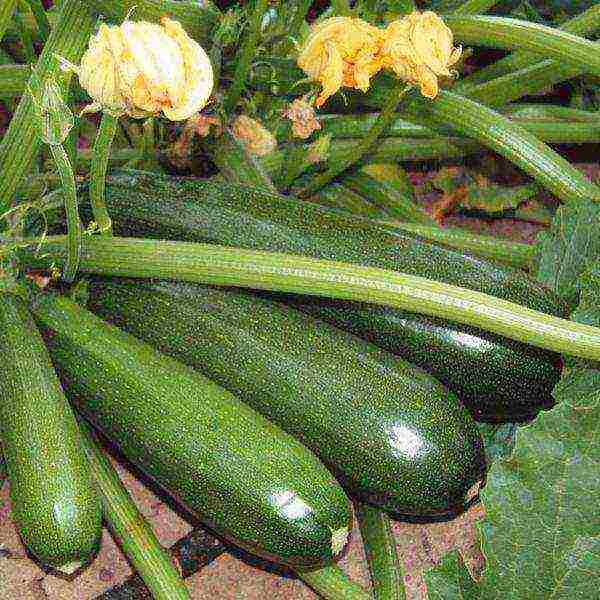 Aeronaut
Aeronaut
White
Ultra-ripe... The first fruits are ready to be harvested within 35-40 days. Fruits of white color, oval, excellent taste, universal purpose The pulp is dense, creamy. Stores well.
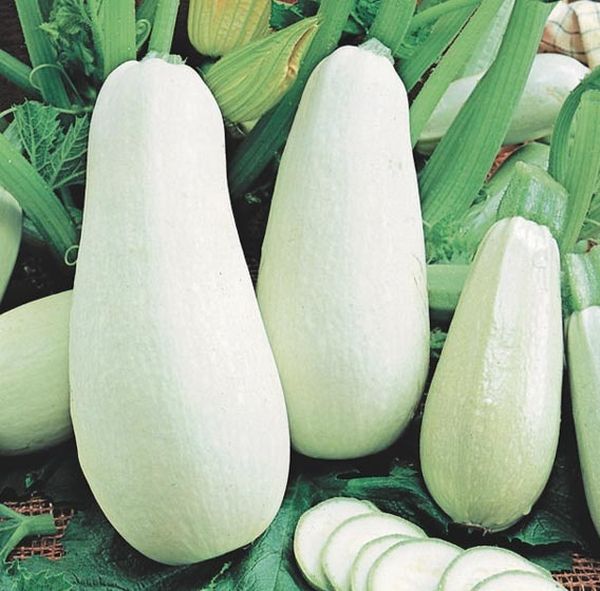 White
White
Waterfall
Early ripe hybrid. Fruits weighing up to 500 g, green. The pulp is dense, white. The yield is high. Disease resistance is above average.
Odessa
Early maturing bush type variety. Disease resistance is very high. The fruits are pale green, cylindrical. The pulp is pinkish yellow or light yellow. Suitable for canning.
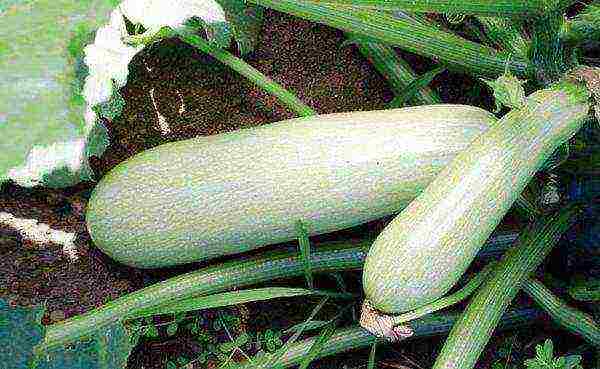 Odessa
Odessa
Best self-pollinated parthenocarpic species
Zucchini forms female and male flowers. In most cases, pollination and fruit setting occurs with insectsthat carry pollen. However, when grown in greenhouses, especially in winter, cross-pollination is problematic.
Parthenocarpic varieties that are able to set fruits without pollination are becoming a real find. Such varieties are also great for open ground.
Kavili
Early ripening and high yields make the Cavili hybrid one of the best.
Fruits are light green, up to 22 cm long. Fruiting is abundant and long-lasting. The ripening period is 1.5 months, and the active setting of new fruits takes place within 2 months in any conditions, even without any participation of pollinating insects. During this time, from 1 sq. m manage to collect about 9 kg... The pulp is tender, juicy, whitish.
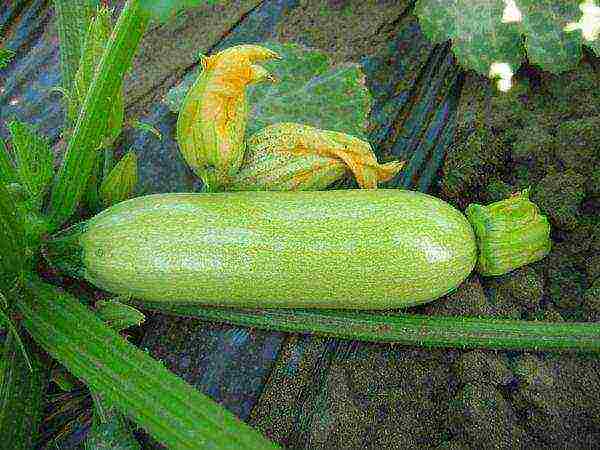 Kavili
Kavili
Jellyfish
Super early hybrid. Ideal for early production under cover films. Withstands large temperature differences.
Ripening period 35 days. The fruits are light green with a delicate skin.The pulp is dense, the seed chamber is miniature. Fruit weight can reach 800 g, with a length of 25 cm.
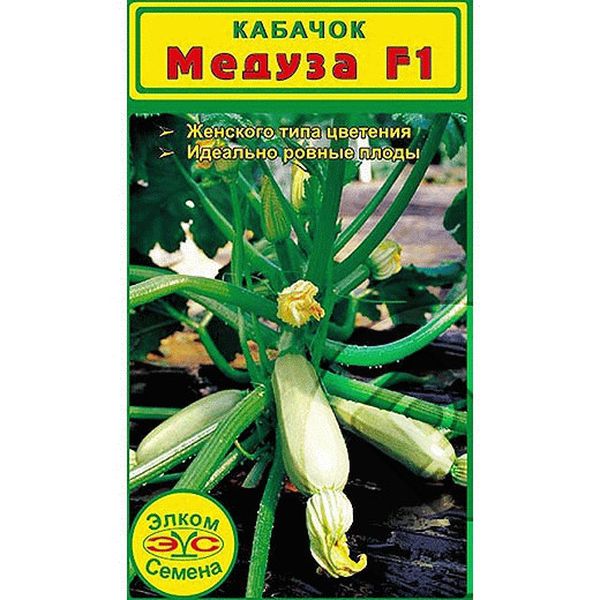 Jellyfish
Jellyfish
Parthenon
A Dutch breeding hybrid, very compact and productive. For 1 sq. m you can place 3-4 bushes and collect up to 15 kg fruits. Good insect-free fruit set and early ripening make this variety an excellent candidate for greenhouse planting.
The fruits of the variety are dark green, cylindrical with light green dense, juicy and tasty pulp. It can be used not only for canning and preparing various dishes, but also eaten raw. Zucchini fruiting period very long and can stretch until September.
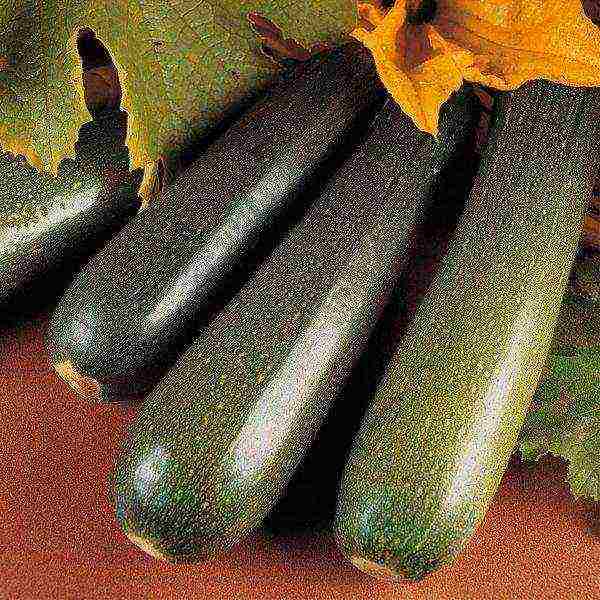 Parthenon
Parthenon
Early varieties
Zucchini varieties of early ripening are of particular value, because it is they who most often become the first fresh vegetables of the new summer season.
Iskander
An early ripe parthenocarpic hybrid developed by Dutch breeders. Ripening period 40-45 days.
The special value of the variety lies in its ability to set fruits at low temperatures, which is especially important for northern regions with cool summers.
When planting 4 plants per 1 sq. m yield is 15 Kg... Iskander fruits are light green, up to 20 cm long, with a thin delicate skin. The pulp is tender, juicy, creamy or white.
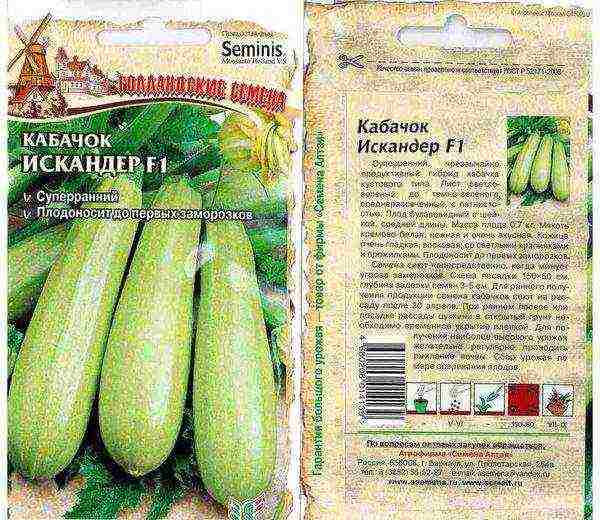 Iskander
Iskander
Tsukesha
The ripening period of the Tsukesha variety is 41-50 days. The plant is characterized by large dark green leaves with gray spots. These are varietal features of color and should not be confused with a disease.
Fruits up to 40 cm long and weighing up to 900 g. Fruiting continues until frost. Fruit well stored and transported... The pulp is juicy, very tasty.
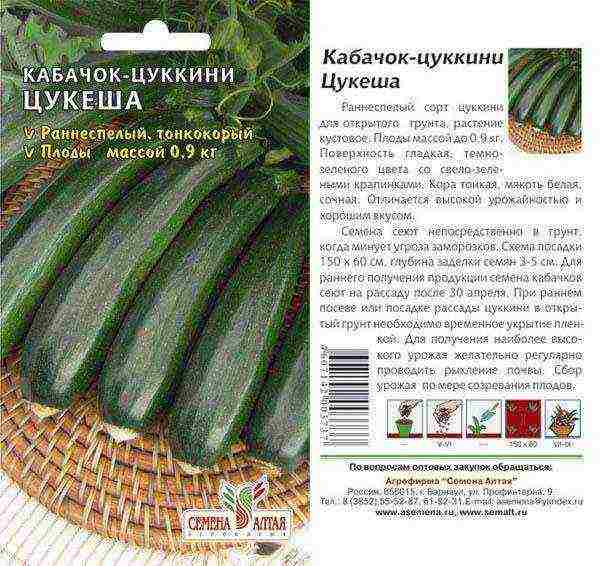 Tsukesha
Tsukesha
Ball
The main feature of the variety is green globular fruit covered with light dots that look like a ball. The pulp tastes excellent.
Ripening period for round squash is 50-55 days. The plant is compact, bushy with strongly dissected leaves.
 Ball
Ball
Aeronaut
This variety has already been mentioned as a popular bush squash, but the early ripening period is another plus in the piggy bank of positive characteristics. Ripening period 42-45 days.
Medium ripening
Gribovsky
The widely known white-fruited variety Gribovsky. Ripening period is not less than 46 days, depending on the region of cultivation. Plant forms long lashes.
Fruits up to 20 cm in size, white. The skin is hard, the flesh is tasty, white or yellowish. Yield 8.5KG from 1 sq. m.
 Gribovsky
Gribovsky
Zolotinka
Ripening period 50 days. Bush type of growth. The color of the fruit is fully consistent with the name.
 Zolotinka
Zolotinka
Black handsome
Bush grade. Ripens in 45 days. Fruits are very dark green in color, close to black. The peel is thin, the flesh is greenish, with a delicate taste.
The fruits are versatile and suitable for all possible uses. At the same time, 4-5 fruits can be tied on a bush.
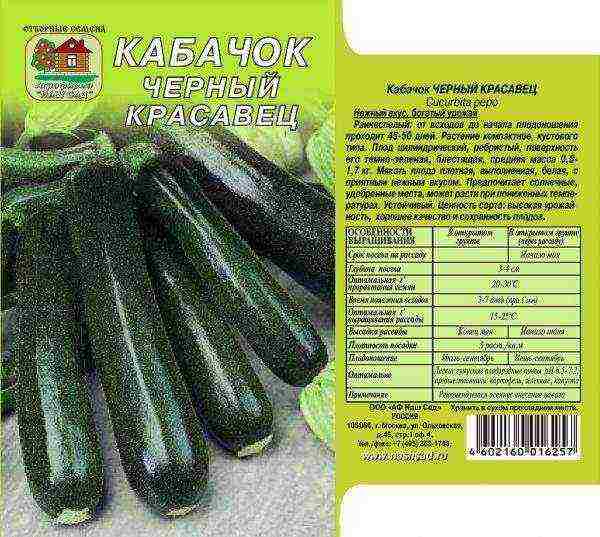 Black handsome
Black handsome
Late zucchini
Spaghetti
An unusual variety that is only gaining popularity.
Young zucchini Spaghetti tastes no different from the usual varieties, but after full ripening, the flesh of the zucchini stratifies into fibers and a peculiar kind is obtained. vegetable spaghettiwhich has many fans. Outwardly, ripe fruits resemble small melons in shape and color.
The only problem - late ripening, which in regions with a short summer does not always allow waiting for "macaroni".
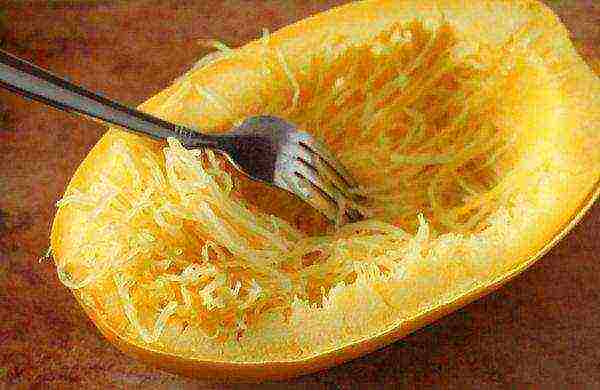 Spaghetti
Spaghetti
Lagenaria (Calabaza)
This type of pumpkin is also called Vietnamese zucchini... Due to the long ripening period and exoticism, lagenaria cannot be called a frequent visitor to vegetable gardens. The shape of the fruit varies.
When young, they are used as food in the same way as pumpkin or vegetable marrow. In a ripe state, the walls and pulp dry out and a cavity forms inside.
Traditionally, this plant was used by some peoples for the manufacture of vessels.
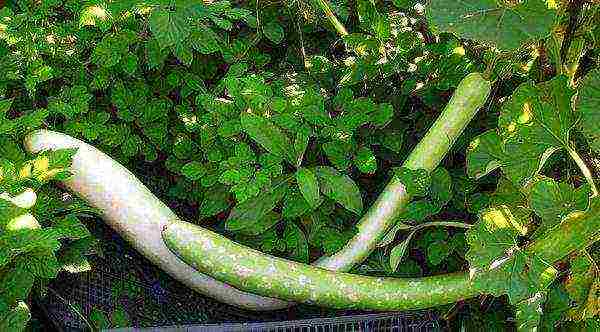 Lagenaria
Lagenaria
The variety of zucchini allows you to choose the right variety not only for certain growing conditions, but also for aesthetic and taste reasons.
With the right combination of hybrids, you can get a good harvest even from a small area and prolong the fruiting period. And some exotic varieties can help diversify traditional culinary dishes and grow craft materials.
White, yellow, green - that's the whole choice
zucchini
, which until recently domestic gardeners were content with. But in the last decade, there has been a breakthrough in the breeding of this vegetable, and a variety of varieties and hybrids have appeared on the market.

In the last decade, there has been a breakthrough in the breeding of this vegetable, and various varieties and hybrids have appeared on the market. The main novelty of recent years has become round squashthat look like small pumpkins. What is there to be surprised - relatives! After all, zucchini is a kind of hard-bore pumpkin, so one would assume that the breeders have gone from what they have come to. But in fact, round zucchini differ from pumpkin in several fundamental qualities:
- First, early maturity. Most hybrids of round courgettes-zucchini bear fruit 40–45 days after germination. Such efficiency makes them desirable almost everywhere, but especially where summers are short enough and not very hot.
- Second, more new varieties - bushy plants, not climbing, and their compactness is in the hands of the owners of modest summer cottages. In addition, many new items are very fruitful. An excellent bonus to yield and early maturity is beautiful carved leaves, bright flowers and fruits, which are not at all indifferent to aesthetic gardeners.
- Thirdly, The flesh of round zucchini squash is white or creamy and not as firm as that of yellow-orange pumpkins, and this is important for gourmet gardeners. Sizes vary (0.5–2 kg), but you can start eating marrow-like balls at a tender age - at a size of 10–15 cm in diameter, which is very convenient for stuffing, canning, and baking.
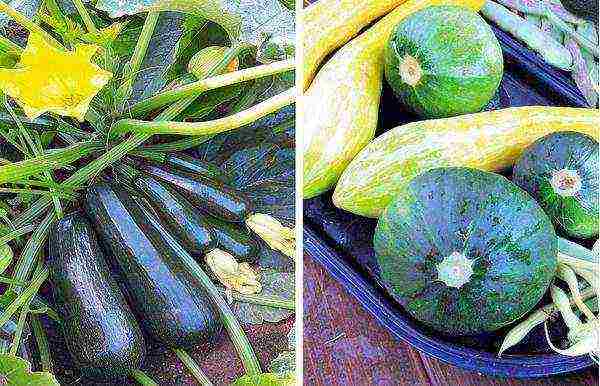
Left: Zucchini 'Tsukesha' (Russian Vegetable Garden). Right: Zucchini ‘F1 Mother-in-law hospitable’ (SeDek) Actually, even the names of new varieties openly hint at this:
- So the form of an early ripe high-yielding bush variety zucchini ‘Casserole’ resembles a pot with a lid, which can be stuffed with vegetables, meat, cheese, cereals. The fruits are beautiful, dark green, weight up to 500 g. The flesh is crispy, very juicy and tasty.
- The main advantage of zucchini F1 ‘Cook’ its juicy creamy pulp is considered excellent.
- Next to it, in terms of taste, you can put grade ‘Cook’, also early ripening (39–43 days from germination to the first harvest) and fruitful.
- Zucchini ‘Tsukesha’ ("Russian Vegetable Garden") - early maturing bush variety without side shoots. Fruits (weight 800-900 g) are distinguished by good keeping quality, thin bark and white juicy pulp.
- Zucchini 'F1 Hospitable mother-in-law' (SeDec) is an early ripe hybrid with beautiful, maturing fruits (weight 1.5-2.5 kg), differs not only in yield, but also in the ability to set up to ten fruits at a time, in addition, tasty fruits are well stored and tolerate transportation without loss.
Zucchini Povarikha F1, 2 g19 rblWATCH
Zucchini Mother-in-law Hlebosolnaya F1, 2 g22 rblWATCH
Zucchini Zucchini Casserole, 6 pcs.29 rblWATCH
Zucchini Zucchini4 rblWATCH
- By the way, the ability to keep well is inherent in many other spherical zucchini, such as 'Ball', 'F1 Gingerbread Man', 'F1 Round Black', 'F1 Round White'... The main thing is not to rush to take them off, allowing them to fully grow and mature.
- Those who love something special should pay attention to zucchini F1 ‘Orange’, which outwardly resembles a melon, which can be eaten fresh.It is easy to guess that the color of the fruit is bright yellow, the flesh is yellowish and sweetish, rich in beta-carotene.
- Just as cheerful, but looks even more impressive zucchini F1 'Festival', although it, of course, most of all both externally (in color and shape) and internally (orange sweetish pulp) resembles a pumpkin. It harmoniously combines attractive appearance and excellent taste. Young fruits are distinguished by sweet tender pulp, and ripe fruits are stored until the next harvest.
- Zucchini ‘F1 Striped Sun’ ("Russian Vegetable Garden")- a handsome man with golden-striped cylindrical fruits of great taste and shoots up to 90 cm long.
- The most original, perhaps, can be called zucchini ‘F1 Watermelon ', on a powerful bush of which (the length of the whips is up to 90 cm) fruits grow in color and shape similar to watermelons. Their flesh is white, sweetish, the seeds are black. Young fruits can be eaten fresh, mature ones - baked, stuffed, fried.
Zucchini F1 Orange47 rblWATCH
Russian Vegetable Garden
Zucchini F1 Watermelon49 rblWATCH
Russian Vegetable Garden
Zucchini Zucchini F1 Gingerbread man17 rblWATCH
Russian Vegetable Garden
Zucchini Boatswain F1, 2 g24 rblWATCH
Important! All these varieties and hybrids are new, only a few of the round squash are included in the State Register of Breeding Achievements, approved for use last year (F1 'Boatswain', ‘F1 Mother-in-law hospitable ', ‘F1 Cook ', ‘Ball '). For the rest of the varieties, we will have to rely on the promises of the producers, since the experience of growing these new products by amateur gardeners has not yet been accumulated. Well, let's experiment.
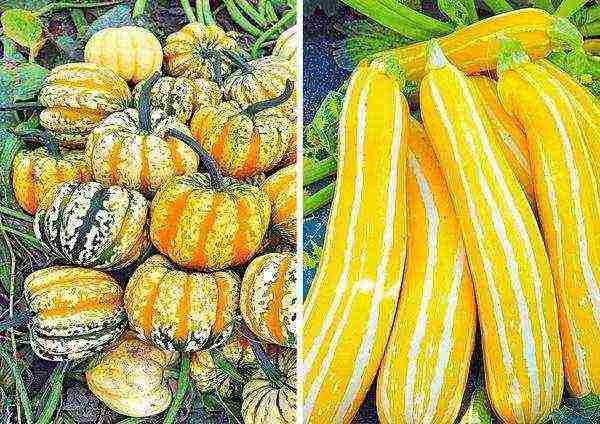
Left: Zucchini ‘F1 Festival’. Right: Zucchini ‘F1 Striped Sun’ ("Russian Vegetable Garden")
The best varieties and hybrids of round zucchini-zucchini of foreign selection
- 'Tondo scuro di piacenza' - medium-early fruitful variety. Fruits are dark green speckled. The pulp is tender, juicy, tasty, creamy. The bark is thin, does not coarse for a long time. The variety is resistant to many diseases. Weight 0.5-1 kg.
- 'Rondo de Nice' - an early ripe fruitful variety with round gray-green fruits. Flesh color: light cream, weight - 0.5-0.7 kg.
- 'Tintoretto' - early ripening variety. The fruit is round, ribbed. The color in the phase of technical ripeness is gray-green, in full ripeness it is yellow, the pulp is white. High and stable yield, excellent taste and culinary qualities. Weight - 1.5-2.2 kg.
Text: O. Uvarova.

